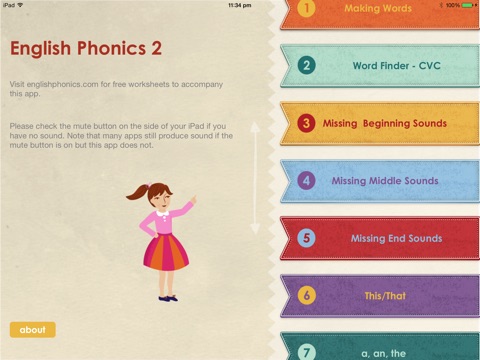
English Phonics 2 has 14 sections that revise and reinforce the CVC (consonant-vowel-consonant) words (cat, sun, fix, etc ) in English Phonics 1 and introduce two new sounds, then blends. As with English Phonics 1, it is advisable to work through each of the 14 sections, repeating where necessary. Move on when the student has a good idea – not necessarily a perfect grasp – of each section.
PARENT/TEACHER HELP FOR BEGINNING READERS IS INVALUABLE !!
Visit englishphonics.com for free worksheets to accompany this and earlier apps.
1. Making Words
Here we have a phonics touch pad that leads to words. Listen for the word and
individual sounds, then tap on the matching tiles. The touch pad has the first sounds (other sounds will be presented in following apps) made by the 26 letters of the alphabet + /-y/ on the end of words like sunny, bunny and /th/, the voiced sound at the beginning of this, that. The – in front of the letter x indicates the sound is at the end of a word such as fo-x. Consonants are black and vowels are red.
2. Word Finder
Based on the traditional find-a-word game, phonics find-a-word "sounds out" the word when the student correctly locates it. The word is selected by sliding a finger across or down the matching letters.
3. Missing Beginning Sounds
It is important for beginning readers to get into the habit of identifying every sound in a word to discourage them from guessing. This activity will help find the beginning sound in CVC words.
4. Missing Middle Sounds
As with previous exercise but now with the middle sound missing. Most students find the middle sounds most difficult to identify.
5. Missing End Sounds
As with previous exercise but now with the end sound missing.
6. This/That
This screen demonstrates the concept of “this” and “that”. “This is near, that is far”. The words "this" and "that" start with the voiced /th/ sound. The letters /th/ can also make the unvoiced sound at the beginning of ‘thin’.
7. a, an, the
These three words all contain a lazy little vowel sound like a soft /uh/ - this sound is distinctly different from the short /u/ sound as in sun. It is called the schwa vowel, and makes reading sound very natural, just like normal talking. The schwa vowel is shown in green.
This vowel is always unstressed, in contrast to the word or syllable that follows. It is at the beginning of ago, away, along, though these words are not taught at this stage of the English Phonics system.
The lazy vowel is the most common sound in English and an understanding of it is very helpful when it comes to understanding the difficulties of spelling.
8. Sentence Word Order
A simple sentence reading and word order exercise.
9. CCVC - Missing 2nd Sound
Like exercises 3,4 and 5 but now the student has to identify the 2nd sound in a CCVC word. Many students will find this difficult.
10. Consonant Blends
All the blends here are made up of two individual sounds, one after another. Before touching the screen you might like to get the student to try to work out the sound of the blends, based on their letter/sound knowledge from English Phonics 1. English Phonics 1 covered all the individual sounds here with the exception of the ‘u’ making a /w/ sounds in the ‘qu’ blend.
11. Blends Making Words
A guided exercise to construct CCVC words.
12. Word Test
A selection of word lists. You can turn the volume down and get the student to try to read every word, or you can turn the volume up and play the game – “tap on the word you hear”. You can also use these lists for spelling/handwriting exercises where the student uses paper and pen.
13. and 14. CCVC Sound Deletion Exercises
Many students find it difficult to identify the 2nd sound in a CCVC word. These two exercises get the student to identify the new word created when the 1st or 2nd sound is removed.



